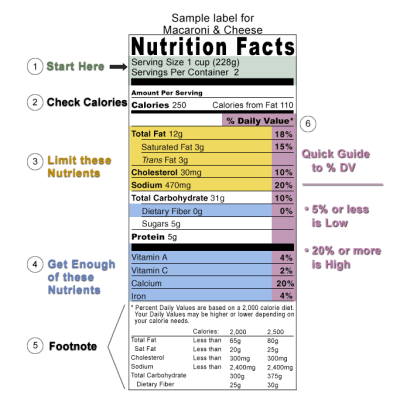Healthy Living
FOOD AND NUTRITION
What is a Nutrition Facts Label?
The Nutrition Facts Label allows you to determine the amount calories and nutrients in one serving of food. The information on the label is important in determining whether you're eating a healthy, balanced diet.
The label, which is included on every packaged food product, lists the amount of:
• Fat
• Total fat
• Saturated fat
• Trans fat
• Cholesterol
• Sodium
• Total carbohydrate
• Dietary fiber
• Sugars
• Protein
• Vitamins and minerals
Here is an example:

What is a serving size?
Serving size is the first thing listed on the label. A serving size is the amount of food that is typically eaten in one serving. It is listed as a general household measurement, such as pieces, cups or ounces (for example, 7 potato chips or 1/2 cup of cereal).
Serving size is an important part of a healthy diet. Eating very large servings, or portions, can contribute to weight gain because as the portion size increases, you're also eating more calories.
Remember, serving sizes may be extremely small (for example, only 7 potato chips or 1 ounce of cake) to make the food seem low-calories or low-fat, so be careful. If you double a serving size, you must also double all the other values on the nutrition label.
What is the Percent Daily Value?
You are supposed to consume a certain amount of fats, carbohydrates (especially fiber), protein and vitamins and minerals each day. You are also supposed to limit certain types of unhealthy ingredients, such as saturated and trans fats. The nutrition label provides a list of percentages (called the Percent Daily Value) that tell you how much of a certain nutrient one serving of food contains, to how much of that nutrient you should consume daily.
One serving of food with 5% or less of the daily value is considered low. One serving of a food with 20% or more of the daily value is considered high.
The Percent Daily Value is based on a daily diet of 2,000 calories. You will need to adjust the percentages if you eat more or less than 2,000 calories per day. For more information on calorie allowances, read our handout on determining calorie needs.
What ingredients should I limit in my diet?
• Saturated fat. Saturated fat can increase your risk of heart disease and high cholesterol. The average adult should consume no more than 20 grams of saturated fat per day.
• Trans fat. Trans fat also increases your risk of heart disease. Ideally, you should get 0 grams of trans fat per day. When you read a nutrition label remember that companies are allowed to list the amount of trans fat as “0 grams” if it contains less than .5 grams of trans fat per serving. This means that your food can contain some trans fat even if the nutrition label says “0 grams” per serving! Always check the ingredient list for trans fat, which will appear as “hydrogenated vegetable oil” or “partially hydrogenated vegetable oil.” Trans fat is usually found in commercially prepared baked goods, fried foods, snack foods and margarine.
• Cholesterol. Limit your total cholesterol intake to less than 300 milligrams per day (and less than 200 milligrams per day if you have heart disease). Read our handout on cholesterol for more information.
What ingredients should I get more of in my diet?
• Fiber. Fiber aids in digestion, as well as lowering your risk of diabetes and heart disease. A food is considered high in fiber if it contains 5 grams of fiber or more per serving. Men age 50 and younger should get at least 38 grams of fiber per day, while women age 50 and younger should consume at least 25 grams of fiber per day. Fiber is found in foods like fruits, vegetables and whole grains. Look for the words “whole grain.”
• Vitamins and Minerals. The nutrition label lists vitamin A, vitamin C, calcium and iron. You should try to get more of these nutrients in your daily diet, as well as other vitamins and minerals that are not listed on the label. You can learn more about vitamins and minerals
Nutrition: How to Make Healthier Food Choices
Why is healthy eating important?
When combined with exercise, a healthy diet can help you lose weight, lower your cholesterol level and improve the way your body functions on a daily basis.
The U.S. Department of Agriculture’s (USDA) Food Guide Pyramid divides food into 6 basic food groups, consisting of
1) grains,
2) fruits,
3) vegetables,
4) meats and beans,
5) diary and
6) fats.
The USDA recommends that an adult daily diet include the following:
• 3 ounces of whole grains, and 6 ounces of grains total
• 2 cups of fruit
• 2 1/2 cups of vegetables
• 3 cups fat-free or low-fat dairy
